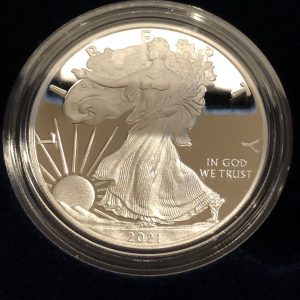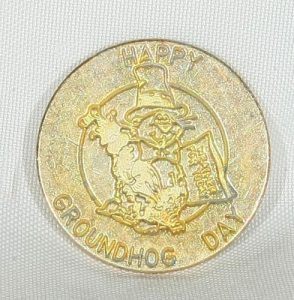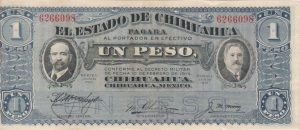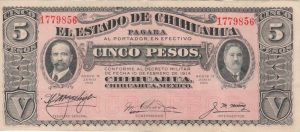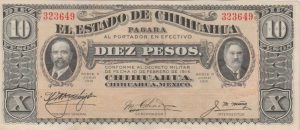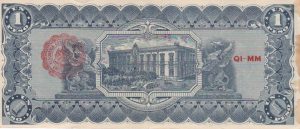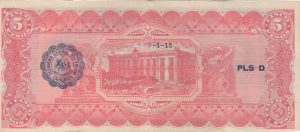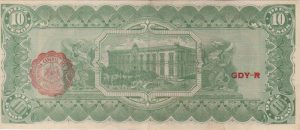How to Create a Price Guide — Planning
Whether you are putting together a price guide or anything to covey information, you must first determine what data you want to report. As I look at the American Eagle series, reporting prices is not the same as a price guide with grades across the top and rows for each year and prices on each row. It is not how American Eagles are collected.
American Eagle coins are collected either in their original mint packaging, also called their original government packaging (OGP), or graded by a third-party grading service and housed in a holder. Based on a quick, non-scientific survey, it does not appear that many people are collecting American Eagle bullion coins and filling holes in albums.
The first decision was easy. American Eagle coins struck for the numismatic market would be priced based on whether the collector had the OGP or not. While using the data from eBay to see if there was a price difference, there was a $10-20 difference for proof coins and an $8-15 difference for other strikes, like the burnished American Silver Eagle coins.
Many people believe that eBay is not a good source of data. Although there is a bias against eBay, the information learned by analyzing the buying trends from such a diverse market can tell a story. I will not base the prices on a survey of only eBay. The book will include a survey of dealer prices and other markets.
The first two columns of prices will be if the coin is in its OGP or not in its OGP. The rest of the table will have columns for graded coins.
Prices for graded coins have different considerations. At what point does the difference between grades become irrelevant? Using the eBay survey, it seems that the numismatic premium is significant for a 70 grade and lesser for 69. When the grade is 68 or lower, the average appears to be bullion cost plus a smaller numismatic premium.
Bullion coins do not come in packages, but there are other considerations. The U.S. Mint packs the bullion coins in special rolls that seem to affect prices. Rolls get packed in monster boxes for shipping to authorized purchasers. Those monster boxes also have a different price structure.
The problem is that the rolls and monster boxes have a limited shelf-life. Although there appear to be some rolls and monster boxes from previous years, most of the rolls for sale are from the current year.
One more consideration is that some collectible American Eagles are only available as part of sets. Sets in their OGP will be priced based on market factors while providing only the price for graded coins in the main tables.
For now, the price tables will look like this:
| Year | Mintage | OGP | <69 | 69 | 70 |
|---|---|---|---|---|---|
| 1986-S | 1,446,778 | 45 | 55 | 72 | 350 |
| 1987-S | 904,732 | . . . | |||
| Year | Mintage | Bullion | <69 | 69 | 70 |
|---|---|---|---|---|---|
| 1986 | 5,393,005 | 35 | 45 | 66 | 220 |
| 1987 | 11,442,335 | . . . | |||
If you have another idea, please leave it as a comment below.
Weekly World Numismatic News for Super Sunday, February 4, 2018
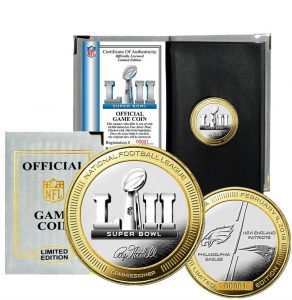
Super Bowl 52 Official 2-Tone Flip Coin
(Courtesy of the Highland Mint)
In 1966, discussions between the upstart American Football League and the National Football League led to the development of a championship game. The idea came from Kansas City Chief’s owner Lamar Hunt to have a single game to crown the championship during the five years it would take to merge the leagues.
The game was called the AFL-NFL World Championship Game and was first played in the Los Angeles Coliseum on January 15, 1967, between the NFL’s Green Bay Packers and the AFL’s Kansas City Chiefs. The game drew 61,846 in a stadium that held over 90,000 people. Halftime entertainment featured Al Hirt and the marching bands from the University of Arizona and Grambling State.
Green Bay, coached by the legendary Vince Lombardi, won the game 35-10. Bart Starr was the game’s MVP. Kansas City was not a bad team, coached by Hank Stram and led by quarterback Len Dawson. But the Packers were just that much better.
The game was broadcast by both NBC and CBS who charged $42,000 per 30-second commercial. It is estimated that the game was seen by more than 51 million people.
The first game to be officially branded as the Super Bowl was Super Bowl III played at the Orange Bowl in Miami. It was also the game that introduced us to significant pre-game hype when New York Jets Quarterback Joe Namath guaranteed a Jets victory over the heavily favored Baltimore Colts. The Colts were led by Coach Don Shula and the legendary Quarterback Johnny Unitas. The Jets’ 16-7 victory has been said to have accelerated the merger between the leagues.
Super Bowl LII will be held in Minneapolis, Minnesota, a nice city but not exactly a “hot” spot in February. U.S. Bank Stadium will be sold out to its capacity of 73,000 and should be seen by a national television audience of over 111 million people. It is estimated that another 30 million, including 4 million from Canada, will be watching around the world.
Advertisers are paying $7.7 million per 30-seconds for their commercials. Adjusting for inflation ($42,000 in 1967 would be the same as $314,711 today), it is costing advertisers almost 24½-times more than the first AFL-NFL World Championship Game. Although the production of the commercials has been a big deal, the gauntlet was thrown down in 1979 when Coca-Cola aired “Hey kid, Catch” starring Pittsburgh Steelers Defensive Tackle “Mean” Joe Greene. If you have not seen it or want to see it again, you can watch it at https://youtu.be/xffOCZYX6F8.
Super Bowl LII marks the 25th year that the Highland Mint of Melbourne, Florida will be striking the medal used in the coin toss. Prior to the making of the official coin, each game either used a coin of their choosing or the host city created their own medal. Of course, the NFL could not pass up a marketing opportunity and has decided to control the process.
After the game, the coin used for the coin toss is sent to the Pro Football Hall of Fame in Canton, Ohio. If there is an overtime game, as there was for Super Bowl LI, the same coin is used as the pre-game coin toss.
The official coin “is carefully struck of fine silver plate and selectively flash plated with 24kt gold,” according to the Highland Mint. Each 1½-inch coin is individually numbered with a mintage limit of 10,000. Super Bowl fans and the fans of the winning team can order one directly from the Highland Mint.
And now the news…
The Wilmington Symphony will premiere ‘The Dance of the Coin’ Feb. 3 at the CFCC Wilson Center. Handling coins is still a regular occurrence for many people. Writing this story served as a reminder that touching these artfully cast pieces of metal is as close as most of us ever come to touching history.  → Read more at starnewsonline.com
→ Read more at starnewsonline.com
More than $50 million worth of gold bars, coins and dust that’s been described as the greatest lost treasure in U.S. history is about to make its public debut in California after sitting at the bottom of the ocean for more than 150 years.  → Read more at foxnews.com
→ Read more at foxnews.com
The Royal Mint is set to honour four generations of the monarchy with a new coin depicting the Queen and three future kings. A new £5 coin will feature Her Majesty and her son the Prince of Wales, grandson the Duke of Cambridge and great-grandson Prince George. The historic coin will show their initials E, C, W and G, and three crowns.  → Read more at standard.co.uk
→ Read more at standard.co.uk
New culture of asking for change surfaced after VAT says Al Tayer  → Read more at gulfnews.com
→ Read more at gulfnews.com
Metal detectorists Paul Adams, 58, and Andy Sampson, 54, began dancing around a field in Suffolk, crying out in joy when they stumbled upon a handful of ancient coins potentially worth £250,000.  → Read more at dailymail.co.uk
→ Read more at dailymail.co.uk
The pool drains into a fountain called a “nymphaeon”—the first such structure found in Israel.  → Read more at newsweek.com
→ Read more at newsweek.com
The US Mint recently began accepting mutilated coins from scrap recyclers after a 2 year hiatus while it investigated an alleged massive Chinese coin fraud operation.  → Read more at motherboard.vice.com
→ Read more at motherboard.vice.com
While many countries are winding down use of physical money in favour of card and app payments, Germans are stubbornly clinging to the clink of coins and rustle of banknotes.  → Read more at gulf-times.com
→ Read more at gulf-times.com
Dubai resident explains his fascination with coins and the story behind his collection  → Read more at gulfnews.com
→ Read more at gulfnews.com
A new 50p coin will be in circulation this year to mark 100 years since women first got the vote.  → Read more at bbc.com
→ Read more at bbc.com
One of the most important pieces of the Super Bowl has a Florida connection. Going inside the factory making the official game coin.  → Read more at firstcoastnews.com
→ Read more at firstcoastnews.com
Six more weeks of winter
There may be a coin, token, or medal that will help celebrate any holiday or occasion.
Someone looking for a collecting idea decided to find out if there was a coin for every holiday or commemoration. After searching online for the last few months, this person found over 150 coins and medals to cover more celebrations than Hallmark has cards for.
I had asked for a sample of some of the finds. There were a few commemorative coins and medals from the United States and foreign made. Many are known, some were a bit obscure.
Then I decided to ask about specific holidays. With Groundhog Day approaching, I asked what was in the collection for that celebration. I was expecting a Canadian coin with a badger or Canadian marmot on the reverse. Instead, I was sent a link to the “Happy Groundhog Day Commemorative Coin.”The Happy Groundhog Day Commemorative Coin is technically a medal. It is a 1½-inch gold-colored medal available from Punxsutawney Phil’s Official Souvenir Shop in Punxsutawney, Pennsylvania. For the low price of 94-cents each (and likely with added shipping costs), you can also have a medal to add to your collection to celebrate Groundhog Day.
When they pulled the poor rodent out of his warm home, probably from a comfortable sleep, and paraded him around, Phil did see his shadow, thus winter will last for six more weeks. Historically, Phil and his ancestors have only been 39-percent accurate.
I wonder if weatherman Phil Connors made it back to Punxsutawney for this year’s celebration?
January 2018 Numismatic Legislation Review
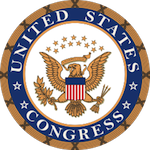 Numismatically, the legislative news of the month is the hold placed on David Ryder’s nomination by Sen. Chuck Grassley (R-IA) in what amounts to a hissy fit over the Department of the Treasury not answering his inquiries. The problem is that to Secretary of the Treasury Steven Mnuchin, it does not matter.
Numismatically, the legislative news of the month is the hold placed on David Ryder’s nomination by Sen. Chuck Grassley (R-IA) in what amounts to a hissy fit over the Department of the Treasury not answering his inquiries. The problem is that to Secretary of the Treasury Steven Mnuchin, it does not matter.
Currently, David Motl is the Acting Deputy Director and the highest-ranking official at the U.S. Mint. Providing department oversight of the U.S. Mint is Treasurer of the United States Jovita Carranza, who has been in office since June 19, 2017. From Mnuchin’s perspective, there is no urgency to have a permanent director when there are two people doing the job.
A source tells me that there is a strange dynamic between Mnuchin and Congress. While he seems to get along with members of the Senate Banking Committee, there are strains in relationships with other members including Grassley, who is the Chair of the Senate Judiciary Committee. One source suggested that Mnuchin may feel that he does not have to answer to the Judiciary Committee since the Banking Committee has more direct oversight of Treasury.
Regardless of the issues, it is preventing Ryder’s nomination from moving forward.
H.R. 770: American Innovation $1 Coin Act
PN1355: David J. Ryder — Department of the Treasury
Weekly World Numismatic News for January 28, 2018
 I wanted to keep this week to writing more about numismatics than commenting on something going on. Unfortunately, that changed with an alert showing up in the Federal Register that the David Ryder nomination is on hold. That put a funk on the week.
I wanted to keep this week to writing more about numismatics than commenting on something going on. Unfortunately, that changed with an alert showing up in the Federal Register that the David Ryder nomination is on hold. That put a funk on the week.
During the week I was able to pick up something for my collection and find a few cool banknotes. That helped pick me up for the week. Adding to my collection is always fun and learning is essential to keeping the mind sharp.
There was a lot of news this week. I was able to whittle the number of interesting stories down to 11. It is compelling to see how numismatics is seen from the non-numismatic media.
There was also a lot of news from the numismatic industry including the announcement of the passing of Ed Rochette. A sad loss for the community.
If you want to keep up with some of the announcements from the community, you can watch the Coin Collectors News site, the sister site to the blog. You can watch the news directly on the site, from the “Recent News” widget on the sidebar, subscribe to the RSS feed ![]() , or subscribe to receive notices by email. If there is news, you will only see one email per day.
, or subscribe to receive notices by email. If there is news, you will only see one email per day.
And now the news….
TEHRAN, Jan. 22 (MNA) – Police officials in Iranian northern city of Qa’emshahr arrested three antique smugglers who were illegally trafficking 299 antique coins of Sassanid era.  → Read more at en.mehrnews.com
→ Read more at en.mehrnews.com
Former landscape architect Ben Huang started his coin cufflink company Patinova after noticing a gap in the market. His jewellery has taken off and he’s branching out into other Chinese-themed accessories  → Read more at scmp.com
→ Read more at scmp.com
Russia now has a coin commemorating the iconic Russian musician, actor, and poet Vladimir Vysotsky, who would be 80 years old on January 25 if he were still alive.  → Read more at rferl.org
→ Read more at rferl.org
Business briefs from the Daily Pilot newspaper.  → Read more at latimes.com
→ Read more at latimes.com
A first look at the new R5 coin celebrating the centenary of Nelson Mandela’s birth  → Read more at brandsouthafrica.com
→ Read more at brandsouthafrica.com
A vast selection of coins and medals is on display at the National Numismatic Exhibition, opened earlier this week at the National Museum of Archaeology in Valletta. It is being presented by Heritage Malta. “This valuable collection shows us and reminds us of our country’s eventful and rich past,…  → Read more at timesofmalta.com
→ Read more at timesofmalta.com
PJ police have managed to recover a unique Roman coin that was stolen from a religious sanctuary in Alijó, Vila Real, Northern Portugal, over 30 years ago in 1985.  → Read more at theportugalnews.com
→ Read more at theportugalnews.com
The tourist attraction lets you 'strike your own coin'  → Read more at walesonline.co.uk
→ Read more at walesonline.co.uk
Melbourne company Highland Mint continues to flip out over its role in Super Bowl — making the *the* Super Bowl coin that decides who gets the ball first.  → Read more at floridatoday.com
→ Read more at floridatoday.com
A stash of gold coins is latest clue that shipwreck 40 miles off NC is that of the steamship Pulaski.  → Read more at charlotteobserver.com
→ Read more at charlotteobserver.com
One man spent £150,000 on the coins – which are now worth no more than £50,000  → Read more at nottinghampost.com
→ Read more at nottinghampost.com
These Chihuahuas are not dogs
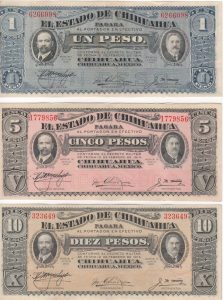 This past week, I was looking into a box I purchased from an estate and I found a plastic bag of old foreign currency. When I removed the notes, I found common notes that can usually be purchased from estate especially since he was a career military officer. There was everything from German Notgeld to several European and Asian countries.
This past week, I was looking into a box I purchased from an estate and I found a plastic bag of old foreign currency. When I removed the notes, I found common notes that can usually be purchased from estate especially since he was a career military officer. There was everything from German Notgeld to several European and Asian countries.
During my search, I found three notes that were intriguing. All three notes were from El Estado de Chihuahua, the State of Chihuahua. They were beautifully preserved (albeit with a fold down the center) one-, five-, and ten-peso notes with the same design but in different colors.
Under the printed denomination are the words “Conforme al Decreto Militar de Fecha Io de Febrero de 1914” (Pursuant to the Military Decree dated February 1914). I vaguely remember that was the era of Pancho Villa and his romp through the southwest United States. Time to refresh my history.
After the 35-yearlong regime of Porfirio Diaz, he was challenged in the presidential election by Francisco I Madero in 1910. Madero was in favor of reform and social justice. But Diaz fixed the election declaring he won by a landslide.
Before the election Diaz had Madero jailed and when it became obvious the election was fixed, Madero supporter Toribio Ortega formed a militia in Chihuahua to oust Diaz.
While in jail, Madero issued a “letter from jail” that declared the Diaz presidency illegal and called for a revolt against Diaz. The revolt began in November 1910. Diaz was ousted and a new election was held in October 1911 that elected Madero the 33rd President of Mexico.
Mexico was divided into districts managed by different governments and protected by rebel leaders including Pascual Orozco, Pancho Villa, and Emiliano Zapata. Eventually, they turned on Madero and assassinated him on February 13, 1913.
The United States first played a role in 1914 when Pancho Villa plundered parts of New Mexico. In 1916, Gen John J. Pershing was sent to Mexico to capture Villa but could not do so since Villa was hiding in the mountains of northern Mexico. Pershing was able to get some of the fighting to stop and, along with the Catholic Church and several affiliated political parties, forced the negotiation of the Constitution of 1917.
Although the notes were authorized in February 1914, the Chihuahua government did not have the ability to print notes. Eventually, they contracted with the American Banknote Company to produce the notes. They were issued in 1915.
To expedite production, all notes feature the same design engraved with different denominations and printed using different colored inks. Many of the elements used were standard to American Banknote’s catalog, for these notes, the portrait on the left is of Francisco I. Madero and the portrait on the right is Governor Abraham Gonzalez. Each features three signatures of the Tesorero General (General Treasury), Gobernator (Governor), and Interventor (Controller). As with many signatures, it is difficult to interpret their names from the handwriting. Please contact me if you have more information.
- Chihuahua Revolutionary 1 Peso Banknote. 1915 Series L (SCWPM #PS530e)
- Chihuahua Revolutionary 5 Pesos Banknote. 1915 Series N (SCWPM #PS532e)
- Chihuahua Revolutionary 10 Pesos Banknote. 1915 Series N (SCWPM #PS535a)
Reverse if these notes feature a framed picture of the Palacio de Gobierno do Chihuahua (Government Palace of Chihuahua) held by two griffins. When the notes were issued from the banks in Chihuahua, they received a red stamp from Tesorero General del Estado Chihuahua (General Treasury of the State of Chihuahua) along with the stamped initials of the issuing teller. When the notes were issued, the teller was supposed to stamp the date on the reverse but that was not universally practiced.
- Chihuahua Revolutionary 1 Peso Banknote. 1915 Series L (SCWPM #PS530e)
- Chihuahua Revolutionary 5 Pesos Banknote. 1915 Series N (SCWPM #PS532e)
- Chihuahua Revolutionary 10 Pesos Banknote. 1915 Series N (SCWPM #PS535a)
In addition to the one-, five-, and ten-peso notes, the Chihuahua government issued 20- and 50-peso notes as well as a 50-centavos fractional note. Both the 20- and 50-peso notes featured the same design except the 20-peso note was printed using brown ink and the 50-peso was printed with a bright green on the front and a golden yellow on the reverse.
The 50-centavo fractional note used a different design and was smaller than the pesos. It was also printed by the American Banknote Company.
These notes were demonetized in 1917 with the signing of the new constitution.
An Educational Opportunity
Money is history in your hands. Look at what can be learned from finding three banknotes and exploring their past and how they fit into history.
Here is an idea for history teachers: you can go to any coin show and find a dealer with a junk box of foreign currency—find more than one if you can to increase the variety. Pick through the box and try to find as many different pieces of currency you can. Try to find a mix of countries, regions, and dates. You can also consider the same country but from different eras of rulers, who always wanted to see their portrait on their country’s money.
Before going to class, place each note in an envelope and place the envelope in a bag. Either pass the bag around the room or have each student come up and pick one envelope. After they pick their currency note, have them write an essay about the note and what the note represents. Have the students look up the history and put it in context of when the note was issued.
Rather than picking a topic, it is a fun way to have the students select a topic and make history come to life. The decisions as to whether the students get to keep the currency are up to you. Maybe you can talk to a local shop or club to see if they would be willing to donate the currency and come in to talk about currency collecting.
